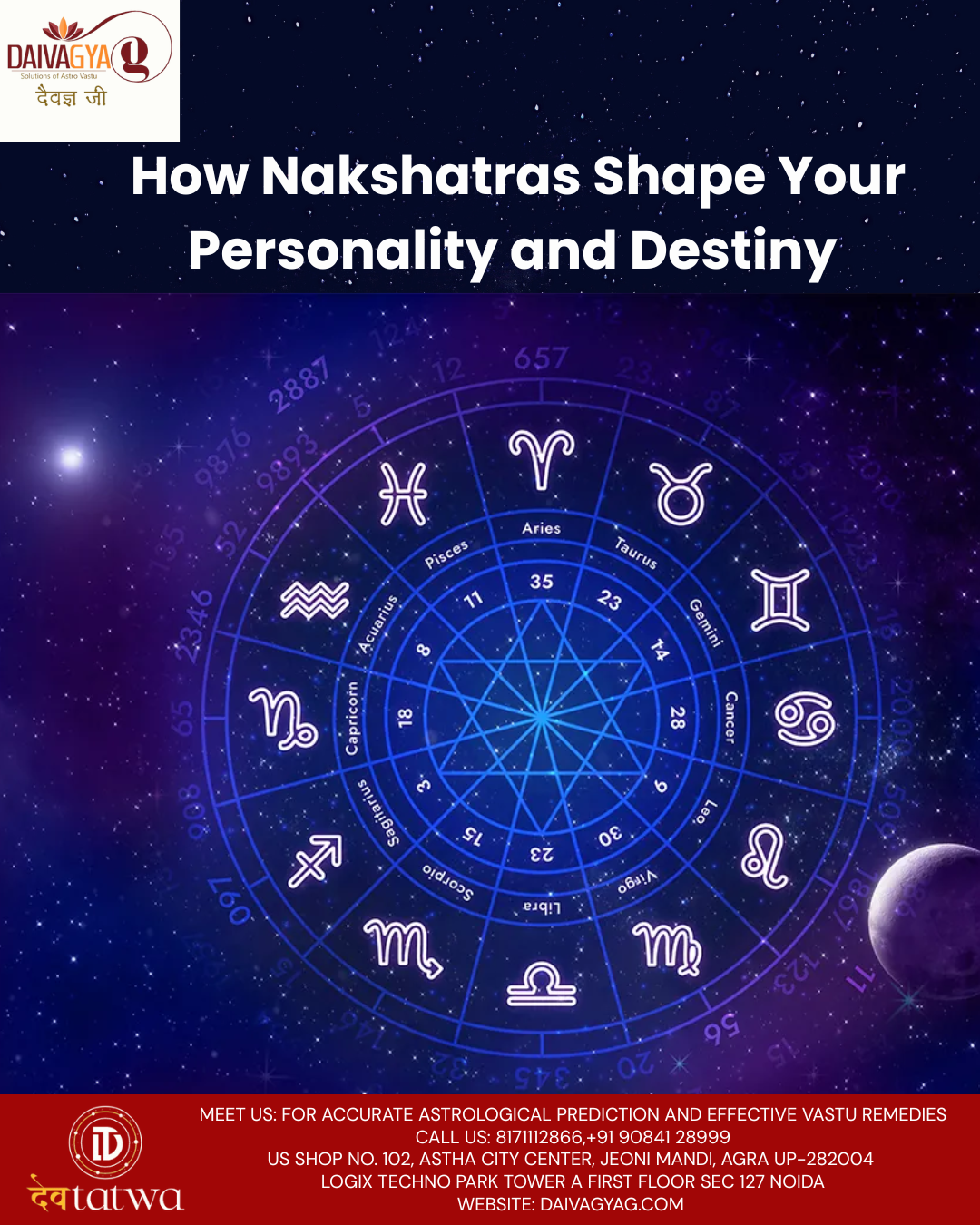How Nakshatras Shape Your Personality and Destiny

How Nakshatras Shape Your Personality and Destiny
Introduction
In the grand science of Vedic Astrology, the zodiac is not only divided into 12 signs but also into 27 Nakshatras (lunar mansions). Each Nakshatra is a cosmic energy center that shapes our personality, destiny, and life journey. These stellar constellations, ruled by different deities and planets, act as the building blocks of human behavior and karmic patterns.
As Dr. Dev Swarup Shastri, renowned astrologer, Vastu consultant, and global guide in Vedic sciences, beautifully explains: “Nakshatras are like the DNA of your soul—they define your inner potential and how destiny unfolds.”
This blog explores the spiritual, psychological, and practical dimensions of Nakshatras, and how they influence who we are and what we become.
What are Nakshatras?
The term Nakshatra means "star domain." In Vedic Astrology, the 360° zodiac is divided into 27 Nakshatras, each covering 13°20′. The Moon—the fastest moving planet—travels through all 27 Nakshatras in about a month. Thus, Nakshatras are directly linked with our mind, emotions, and inner tendencies.
Each Nakshatra has:
-
A ruling deity – Symbolizing divine energy.
-
A planetary ruler – Influencing worldly behavior.
-
A symbol – Representing hidden qualities.
For example, Rohini Nakshatra, ruled by the Moon and symbolized by a chariot, brings beauty, creativity, and prosperity, whereas Ashwini Nakshatra, ruled by Ketu and symbolized by horse-headed twins, represents healing, speed, and vitality.
The Role of Nakshatras in Shaping Personality
Your Janma Nakshatra (birth star—where the Moon was placed at birth) is one of the most important indicators of personality. It defines mental outlook, character traits, strengths, and weaknesses.
How Nakshatras influence personality:
-
Behavioral Patterns: Some Nakshatras make people bold and adventurous (e.g., Ashwini, Magha), while others make them thoughtful and spiritual (e.g., Uttara Bhadrapada, Revati).
-
Emotional Responses: The Moon’s placement in a Nakshatra shapes how one reacts emotionally. For instance, those born under Ardra often experience intense emotions, while those under Rohini are calm yet ambitious.
-
Life Approach: Nakshatras determine if a person will seek material success, spiritual growth, or balance both.
As Dr. Dev Swarup Shastri explains: “Nakshatras act like personality blueprints—they silently guide our thoughts, choices, and interactions.”
Nakshatras and Destiny: The Karmic Connection
Nakshatras are not just psychological markers—they carry karmic imprints from past lives. Each Nakshatra has a specific energy flow, aligning individuals with certain events, opportunities, and challenges.
-
Career & Talents: For example, Dhanishta gives musical talent, while Hasta grants skillful hands for arts and healing.
-
Relationships: Nakshatras reveal compatibility in marriage and partnerships. Some pairings are naturally harmonious, while others require effort.
-
Spiritual Path: Certain Nakshatras (like Purva Ashadha or Shravana) push individuals toward higher learning and spirituality.
This karmic mapping helps astrologers refine predictions about destiny.
Classification of Nakshatras and Their Influence
1. By Guna (Nature):
-
Sattvic Nakshatras (e.g., Shravana, Revati): Promote spirituality, purity, and wisdom.
-
Rajasic Nakshatras (e.g., Rohini, Swati): Encourage ambition, desires, and creativity.
-
Tamasic Nakshatras (e.g., Ardra, Moola): Represent transformation, struggle, and rebirth.
2. By Varna (Temperament):
Nakshatras are associated with Brahmin, Kshatriya, Vaishya, or Shudra qualities, influencing profession and duties.
3. By Animal Symbols:
Each Nakshatra is linked to an animal symbol, reflecting instinctive behavior. For example, Bharani (Elephant) signifies strength and responsibility, while Swati (Buffalo) indicates independence.
How Nakshatras Affect Different Life Areas
🌙 Personality & Mindset
Your Janma Nakshatra shows how you think, feel, and express yourself.
💕 Relationships & Marriage
Nakshatra compatibility (Nakshatra Milan) is vital in Vedic astrology for marriage. It ensures emotional and spiritual harmony.
💼 Career & Success
Some Nakshatras bless individuals with leadership (Magha, Uttarashada), while others excel in communication and arts (Mrigashira, Rohini).
🕉️ Spiritual Growth
Nakshatras like Punarvasu, Shravana, and Revati guide souls toward dharma, meditation, and higher consciousness.
Famous Nakshatras and Their Traits
-
Ashwini (0°–13°20′ Aries): Energetic, adventurous, natural healers.
-
Rohini (10°–23°20′ Taurus): Creative, attractive, material prosperity.
-
Magha (0°–13°20′ Leo): Royal, authoritative, ancestral pride.
-
Swati (6°40′–20° Libra): Independent, flexible, intellectual.
-
Moola (0°–13°20′ Sagittarius): Truth-seekers, transformative energy.
-
Revati (16°40′–30° Pisces): Compassionate, spiritual, protectors.
Practical Application: How to Use Nakshatra Wisdom
-
Self-Discovery: Knowing your Nakshatra helps you understand your strengths and weaknesses.
-
Relationship Harmony: Matching Nakshatras before marriage enhances compatibility.
-
Career Choices: Certain professions align better with specific Nakshatra energies.
-
Spiritual Remedies: Chanting specific mantras, wearing gemstones, or following rituals aligned with your Nakshatra can balance negative effects.
Dr. Dev Swarup Shastri advises: “Aligning life decisions with your Nakshatra creates harmony between inner potential and cosmic design.”
Conclusion
Nakshatras are the subtle cosmic energies that shape both who we are and where we are headed. They are not just stars in the sky, but living forces influencing our thoughts, emotions, relationships, and spiritual path.
At DaivagyaG, guided by the timeless wisdom of Dr. Dev Swarup Shastri, we believe that understanding Nakshatras empowers individuals to embrace their destiny with awareness. By exploring the secrets of your Nakshatra, you unlock the hidden map of your personality and life journey.

